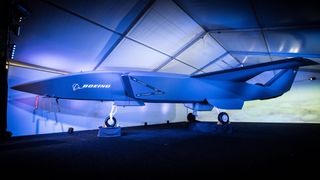Air shows like that held at Avalon last week are usually industry-heavy affairs. Lots of announcements regarding new widgets and dealmaking between industry players, all with fighter jets screaming overhead.
But outgoing Defence Minister Christopher Pyne used this year to make a genuinely significant announcement on something that caught many analysts by surprise.
It’s the first combat aircraft designed in Australia since the 1950s.
He revealed that the Royal Australian Air Force, in partnership with Boeing, has been developing an unmanned air combat vehicle, the Air Power Teaming System.
It’s the first combat aircraft designed in Australia since the 1950s.
On this point alone the potential flow-on benefits from designing unmanned combat systems in Australia are a positive development for our sovereign defence industry and capability.
The new drone, if successfully fielded, will also help address some regional military challenges.
The autonomous system is designed to be teamed with human pilots in missions with Australia’s combat aircraft, including the F-18E/F and F-18 Growler electronic warfare attack aircraft.
It will also participate in maritime patrol missions with the P-8 Poseidon planes.
One of the long-term challenges for middle powers is that every generation of aircraft is more expensive to buy and maintain than the last.
While Australia’s defence budget has bipartisan support to reach and maintain a healthy 2 per cent of GDP, new submarines, naval shipbuilding and other capital programs are taking an increasingly large portion.
For all its reported faults, the F-35 is an incredibly complex aircraft with sophisticated sensor, communication and intelligence capabilities and coated in advanced materials, much more so than previous generations.
The result is a high per-hour flying cost, requiring larger portions of the defence budget to maintain and operate.
While Australia’s defence budget has bipartisan support to reach and maintain a healthy 2 per cent of GDP, new submarines, naval shipbuilding and other capital programs are taking an increasingly large portion.
There is likely little room for new numbers of fifth-generation fighters like the F-35.
It may be that many air forces in the West originally envisioned fighter fleets that would be entirely made up of advanced stealthy fifth-generation aircraft — but cost overruns and constricted defence budgets have forced them to find middle ground.
The need for stealth, a foundational design feature of the F-35, has also necessitated a reduced weapons payload capacity.
With these factors in mind, there is a growing trend, including in the US, towards a mix of fourth and fifth-generation aircraft. The idea is that F-35s will be tasked with entering dangerous environments, relying on stealth and electronic warfare capabilities to survive, while spotting targets for lower-tech unmanned systems, like the new RAAF-Boeing drone, and non-stealthy fighters that remain outside the range of adversary defences.
The largest benefit of these systems will be to beef-up its mass, or the amount of presence and firepower it will be able to project across the region against large numbers of adversary aircraft.
This is where the just announced unmanned system comes into play. This “loyal wingman” will be paired with fourth-generation manned aircraft such as F-18s and will likely act as decoys, scouts and communication relays. Eventually they may play a “bomb truck” role, carrying additional missiles and ordnance for both air-to-air combat and other strike missions.
The largest benefit of these systems will be to beef-up its mass, or the amount of presence and firepower it will be able to project across the region against large numbers of adversary aircraft.
A single F-18 with four to six autonomous wingmen in tow would be better able to survive, while being more lethal and numerous, multiplying its impact.
This will allow us to maintain the number of expensive F-35s we’ve purchased and started to operate but supplement them with lower-tech aircraft and these potentially cheaper and useful autonomous wing-mates.
The other focus of the announcement was with an eye on the export potential of the new system. It’s no secret that multiple countries across our region are modernising their militaries and are looking for avenues to bolster their forces in novel and inexpensive ways.
With China’s military power continuing to expand, both in sophistication and size, finding ways to deter and deny the People’s Liberation Army from opportunism will be critical for Canberra and like-minded partners. In this vein, helping regional militaries improve their ability to be aware of their surroundings and defend themselves will be in our long-term interests.
How this will work in practice and how much economic benefit will flow to Australia’s defence industry is less certain.
US foreign military sales and defence import and export regulations are a notoriously restrictive and difficult operating environment for businesses both in the US and Australia. Some commentators have suggested the investment by Boeing in Australia — the largest investment in unmanned systems outside of the US by the company — is a way around them.
But it appears whether this new system is built in the US or Australia may ultimately depend on where it is likely to be exported.
There may be US restrictions on installing advanced US-designed and produced electronic warfare suites and sensors on Australian-manufactured aircraft that would then be sold to a third country. Some countries may have arrangements with Washington, allowing them to purchase the aircraft from the US directly.
A senior Boeing official hinted at this when questioned last week, saying where the aircraft is built “depends on the market”.
This may be one compromise Canberra took when it looked for ways to kickstart an unmanned aircraft defence industry in Australia — a crucial and positive strategic decision.
We should now concentrate our efforts on breaking down barriers between further technological and industrial co-operation so we can build a sustainable sovereign defence industrial capability.






